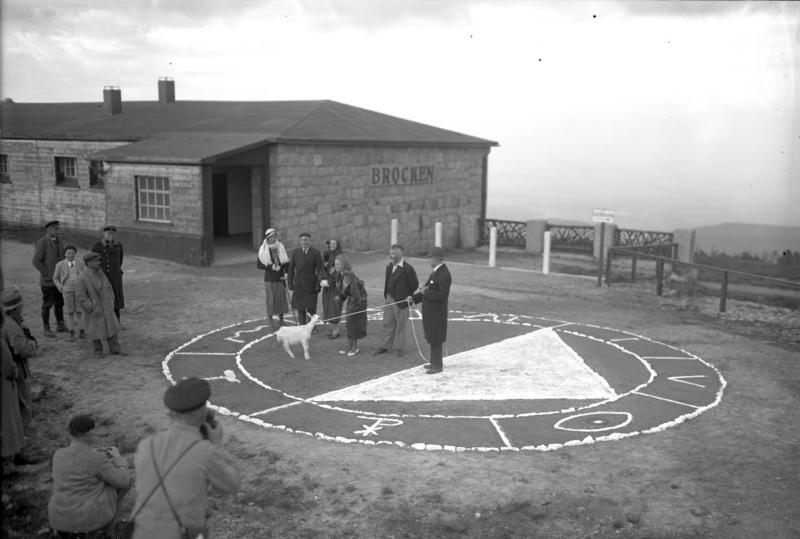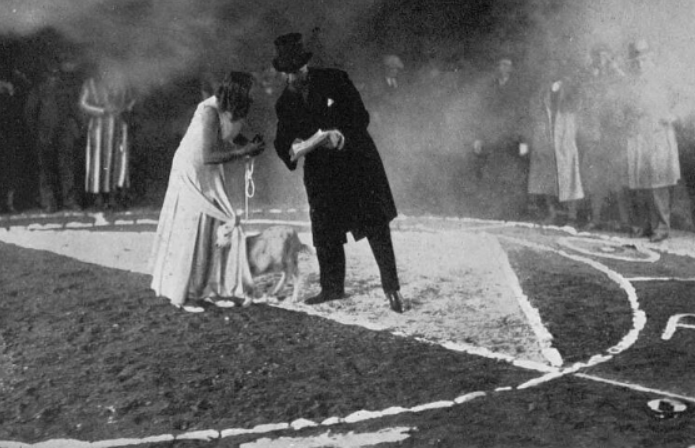When Science and the Occult Went Head-to-Head on a German Mountaintop
Spoiler alert: science won.

Germany’s Harz mountains have historically been associated with witches, spirits, and black magic, particularly the range’s highest peak, the Brocken. Back in 1932, one brave skeptic set out to test just how mystical the Brocken truly is by performing a ritual there designed to turn a goat into a little boy.
That skeptic was Harry Price, an early paranormal investigator and debunker. Over the course of his long career, Price labored to bring reason and a scientific eye to the world of the metaphysical. By the time he decided to take a goat to the Brocken, he’d already been responsible for blowing the lid off of spiritualists, psychic photographers, and at least one talking mongoose.
Price’s attempt at a magical ritual atop the Brocken came about thanks in part to the writer Johann Wolfgang von Goethe. Goethe famously had an interest in the occult, and visited the Brocken peak, hiking a path that is still memorialized as the Goethe Way. Inspired by the mysterious atmosphere of the Harz region, Goethe set portions of his most famous play, Faust, there, including the surreal walpurgisnacht scene where the devil Mephistopheles leads Faust around the Brocken, observing witches and even a gorgon. “Paganism died hard in the Harz country,” Price would later write.

Goethe died in 1832, but his legacy is celebrated around the Harz, and on the centennial anniversary of the author’s death, Price got in on festivities. That year, he and fellow philosopher C.E.M. Joad traveled to the Brocken to stage their own large-scale magic ritual.
According to Price’s account of the event in his book Confessions of a Ghost-Hunter, he’d come into possession of an arcane grimoire called the High German Black Book, which contained a number of spells and rituals. Apparently discovering that Price was in possession of this book of old magic, the organizers of the Goethe centennial celebration invited him to come and perform some magic. Price jumped at the chance, thinking it a perfect opportunity “to emphasise the absolute futility of ancient magical ritual under twentieth-century conditions.”
One of the spells in the book was the ‘Bloksberg Tryst,’ a ritual designed to transform a young male goat into a human boy. Bloksberg was an older name for the Brocken, and the directions for performing the Bloksberg Tryst stated that it could only successfully be performed atop the peak, under the light of a winter’s full moon.

According to the elaborate ritual text, the he-goat must be led by a silken cord held by a “mayden pure in heart in fair white garments.” Incense must be burned, and a pine fire lit. Standing on a magical circle that has been drawn on the ground, the maiden must spin the goat three times, then pour wine over its head, while reciting some magic words (Procul O procul este profani—Begone, begone, ye profane ones). When the magic starts to work, the moon is said to go dark, and the maiden then needs to cover the goat with a white sheet. When the cloth is removed, the goat should be gone, replaced with a human boy.
Price, looking to make a true spectacle of the ritual, contacted a number of reporters to come and witness the magical experiment. Then, on June 17, 1932, Price attempted to turn a goat into a boy. For a maiden fair, he brought along Urta Bohn, the daughter of a Bresleau attorney. She dutifully wore a pure white dress that Price felt was right at home at a magical working.
Following the preparations laid out in the book, Price had put together a truly arcane scene, with a large magical circle set into the ground, and incense burning away. In his account of the experiment, Price writes that the only thing that seemed out of place were the dozens of reporters and photographers on the periphery.

The moon was somewhat obscured by clouds that night, but otherwise the ritual went off without a hitch—save for it not actually working. “The Press reports of this rehearsal rather stressed the point that the ‘goat remained a goat,’ as if the reporters really anticipated the appearance of the magical Adonis,” writes Price.
For the sake of science, Price and company came back the next night as well, leaving the press behind, and performed the ritual a second time. The result was, unsurprisingly, the same.
Some news outlets reported on the experiment as if it was a joke, but generally the response was positive. Price writes, “[M]ost of the papers realised that the trial of such experiments is worth while, the Evening Standard remarking (June 18, 1932) that the ‘investigation of them is a step forward in the progress of science .... The true scientist inquires into the meaning of all phenomena without prejudice.’”
Today the Brocken happily plays up its witchy roots, not unlike a German version of Salem, Massachusetts. But in at least in this instance, Price tried to bring real magic to the area, even if it didn’t work.











Follow us on Twitter to get the latest on the world's hidden wonders.
Like us on Facebook to get the latest on the world's hidden wonders.
Follow us on Twitter Like us on Facebook